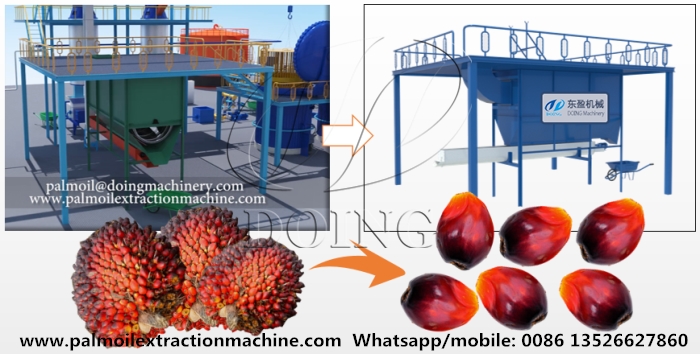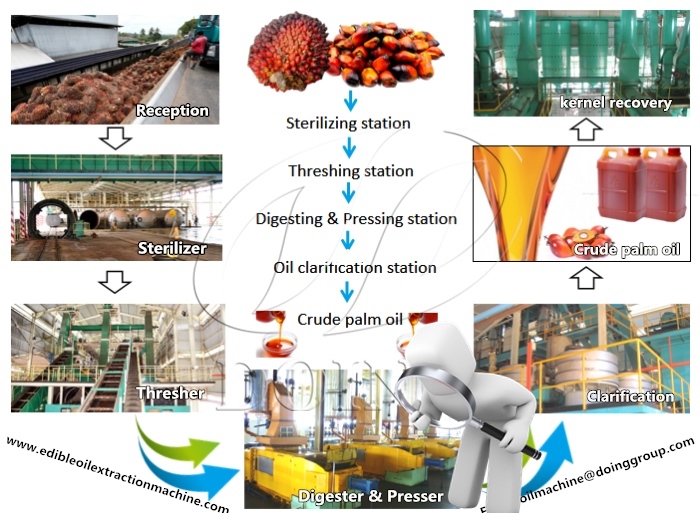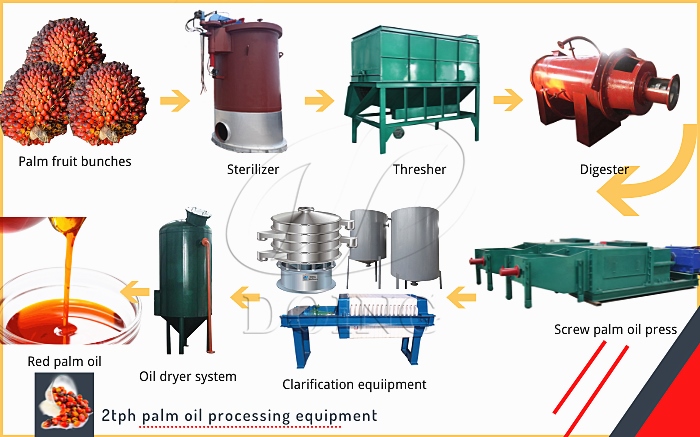Common problems and solutions in palm oil production process
FAQ / Chat on line / Give me a price / Date:2025-02-07
In the palm oil production process, achieving the high quality palm oil requires not only the right technology and palm oil processing equipment but also addressing the common problems that can arise during palm oil production process, such as the handling of palm fruit bunches, sterilization time, crushing and pressing process, and refining. Henan Glory specializes in providing advanced solutions for the palm oil production, ensuring the production of pure, high-quality palm oil. In this article, we will discuss the most common problems and solutions of palm oil production process, enhancing both efficiency of palm oil production and final product quality.
Fresh Fruit Bunch (FFB) Handling
Problem 1: Delayed Processing of FFBs
Description: If FFBs are not processed in a timely manner after harvesting, the oil content can degrade due to the action of enzymes. This leads to a reduction in the overall oil yield and a decrease in the quality of the extracted oil, with increased levels of free fatty acids (FFAs).
Solution: Establish an efficient transportation system from the plantation to the palm oil processing plant to minimize the time between harvesting and processing. It is the best to process the palm bunches in 48 hours. The use of well - maintained trucks with proper ventilation can help. Additionally, setting up a scheduling system at the mill to ensure that FFBs are processed as soon as they arrive can significantly reduce the negative impact of delays.
Problem 2: Inadequate FFB Cleaning
Description: FFBs may contain dirt, sand, leaves, and other impurities. If these are not removed properly before palm oil production process, they can cause damage to the palm oil processing equipment, such as blockages in pipes and wear - and - tear of crushers. Moreover, impurities can contaminate the oil, affecting its quality.
Solution: Implement a multi - step cleaning process. This can include initial screening to remove large debris, followed by washing with water jets to remove smaller particles. Using vibrating screens and conveyor belts with appropriate mesh sizes can also help separate impurities from the FFBs effectively.
 Palm fruit thresher
Palm fruit thresher
Sterilization
Problem 1: Uneven Sterilization
Description: In the sterilization process, which is crucial for inactivating enzymes and facilitating the separation of palm fruits from the bunches, uneven heating can occur. Some parts of the FFBs may not be fully sterilized, while others may be over - sterilized. Under - sterilized FFBs can lead to incomplete oil extraction and higher FFA levels, while over - sterilized FFBs can cause the oil to have a burnt taste and reduced nutritional value.
Solution: Use advanced sterilization equipment with proper temperature control and uniform heat distribution. For example, continuous - flow sterilizers with well - designed steam injection systems can ensure that all FFBs are exposed to the appropriate temperature for the required time. Regular calibration of temperature sensors and maintenance of the sterilization equipment are also essential.
Problem 2: Sterilization Equipment Malfunction
Description: Mechanical failures in sterilization equipment, such as leaks in steam pipes, faulty valves, or problems with the conveyor system within the sterilizer, can disrupt the sterilization process. This not only affects the quality of the FFBs but also causes palm oil production process delays.
Solution: Establish a regular maintenance schedule for the sterilization equipment. This includes daily inspections for visible signs of wear and tear, weekly checks of critical components like valves and sensors, and monthly or quarterly comprehensive maintenance. Keep spare parts on hand for quick replacement in case of failures. Additionally, training the operators to recognize early signs of equipment malfunction can help in taking preventive measures.
Threshing and Digestion
Problem 1: Incomplete Threshing
Description: Threshing is the process of separating palm fruits from the bunches. If the threshing equipment is not properly adjusted or maintained, some fruits may remain attached to the bunches, resulting in reduced oil extraction efficiency.
Solution: Regularly adjust the threshing machine according to the characteristics of the FFBs, such as the size and hardness of the bunches. Check and replace worn - out threshing elements, like rubber beaters or metal combs, in a timely manner. Operators should also be trained to monitor the threshing process and make adjustments as needed.
 Large scale palm oil processing machine with capacity 60tph 80tph 100tph
Large scale palm oil processing machine with capacity 60tph 80tph 100tph
Problem 2: Poor Digestion
Description: During digestion, the palm fruits are cooked to break down the cell walls and release the oil. If the digestion process is not optimized, the oil may not be fully released, leading to lower oil yields. Factors such as incorrect temperature, insufficient cooking time, or improper mixing can contribute to poor digestion.
Solution: Optimize the digestion parameters based on the type of palm fruits. Use temperature - controlled digestion vessels with accurate temperature sensors. Ensure proper mixing of the fruits during digestion, for example, by using mechanical stirrers or by designing the digestion tank with a shape that promotes natural convection. Conduct regular tests to measure the oil release rate and adjust the digestion process accordingly.
Palm Oil Extraction
Problem 1: Low Oil Extraction Efficiency
Description: Inefficient oil extraction can be caused by various factors, including improper adjustment of the screw press, wear - and - tear of the extraction equipment, or using old - fashioned extraction methods. This results in a significant amount of oil remaining in the palm kernel and mesocarp residues, reducing the overall yield.
Solution: Upgrade to modern oil extraction technologies, such as the use of high - efficiency screw presses with adjustable pressure settings. Regularly maintain the extraction equipment, including replacing worn - out parts like the press screw and the filter cloth. Implement pre - treatment methods, such as flaking the palm kernels, to increase the surface area and improve palm oil production efficiency.
Problem 2: Emulsion Formation
Description: During the palm oil production process, especially in the wet - extraction method, an emulsion can form between the oil and water phases. This makes it difficult to separate the oil from the water, leading to oil losses and a lower - quality final product.
Solution: Add demulsifying agents to break the emulsion. These agents can be selected based on the nature of the emulsion formed. Adjust the pH of the extraction mixture within the appropriate range, as this can also help in separating the oil and water phases. Using centrifuges with proper operating parameters can effectively separate the oil from the emulsion by taking advantage of the density differences between the oil and water.
 Palm oil processing equipment.jpg
Palm oil processing equipment.jpg
Palm Oil Refining
Problem 1: High Free Fatty Acid (FFA) Content after Refining
Description: If the palm oil refining process is not carried out correctly, the final palm oil may still have a relatively high FFA content. High FFA levels can cause the oil to have an unpleasant taste, a shorter shelf - life, and can also affect its performance in various applications.
Solution: Optimize the neutralization step in the refining process. Use an appropriate amount of caustic soda (sodium hydroxide) solution to react with the FFAs and form soapstock, which can be removed. Monitor and control the reaction conditions, such as temperature, mixing speed, and reaction time. Additionally, consider using advanced refining techniques like physical refining for better FFA removal in some cases.
Problem 2: Discoloration of Refined Oil
Description: Palm oil may develop an undesirable color during the refining process, which can be due to improper bleaching or the presence of certain pigments that are not effectively removed. Discolored oil may be less appealing to consumers and may not meet the quality standards for some applications.
Solution: Use an appropriate amount of activated clay or other bleaching agents during the bleaching process. The selection of the bleaching agent should be based on the nature of the pigments present in the oil. Adjust the bleaching temperature and time to ensure effective color removal. After bleaching, proper filtration should be carried out to remove the spent bleaching agent and any remaining impurities.
In summary, the quality of palm oil can be significantly improved by treating the common problems of palm oil production process with appropriate solutions. If you are looking for advanced solutions, please feel free to contact Henan Glory. Henan Glory's palm oil processing equipment has the advantages of stable operation, easy maintenance and energy saving. Besides, our professional engineer team can offer all-round technical support, welcome to consult us for more details.

 Call us
Call us Chat online
Chat online

